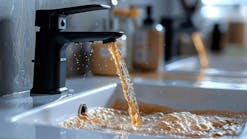Reverse osmosis (RO) is becoming a common method for treating residential drinking water. While many consumers know RO best for its use in desalination, it is also effective for treating water quality problems in the home.
RO reduces the amounts of organics, inorganics, bacteria and particulates found in water, as well as other solids and salts. The process has been refined to address the hard water concerns and sanitary needs of swimming pools, with technologies designed specifically for use with residential and commercial pools.
System Basics
RO is based on the process of osmosis and involves the selective movement of water from one side of a membrane (a tightly wound composite) to the other. To make the process work, high pressure is applied to the feedwater, forcing it through the membrane. Because contaminants do not move with the water across the membrane, purer water collects and is captured on the other side of the membrane. The purified water that accumulates is drinking water quality and is sent back into the swimming pool. High pressure is necessary to separate purified water and contaminants and to ensure efficiency and minimal water waste.
The pressure required is based on the type and concentration of contaminants in the water. Supplying more pressure than required to the contaminated water provides better separation and a higher production rate, but can result in fouled membranes. Care is needed to find the optimal balance between recovery and failure of the membranes (fouling). This is one of the largest hurdles to overcome when building this type of system.
Removal efficiency often is described using the term “rejection percentage,” which is the percentage of a particular contaminant that does not cross the membrane. While this information is critical, rejection percentages do not tell the whole story. For example, the rejection percentage for nitrates can be as high as 90% with some systems, indicating that the membrane is highly efficient in rejecting them. It is important to know not only rejection percentages, but also incoming pollutant concentrations, to effectively reduce contaminant concentrations in the water to safe levels.
Ensuring Success
Basic components of an RO system include a prefilter to remove fouling agents such as rust and lime; an RO module containing the membranes; an injection system capable of neutralizing scale and chlorine; and various valves, including a shutoff valve that stops the water flow when the system shuts down after processing. The system also must provide for waste flow to carry away the brine solution (roughly 15% of the pool water) to an approved drain location.
Properly sourced components are critical to handling the unique characteristics of swimming pool water, and the different water conditions and needs of each pool, and to maximize efficiency and minimize water waste in the brine stream. While not required, a remote monitoring system and on-board power are helpful when utilizing RO in the swimming pool industry.
To ensure peak performance, RO systems require regular maintenance and replacement of various components. Prefilters and injection chemicals need to be installed to protect membranes; the length of time between changing prefilters will depend on water quality, especially the concentration of solids. The contaminant concentration, membrane rejection percentages and efficiency all determine when prefilters should be replaced. RO membranes typically last three to five years, depending on operating conditions, membrane type, and prefilter and injection chemical performance.
One example of this type of system is the Puripool Process, created by Pool Services Technologies Inc. The company has built and operated RO trailers for the swimming pool industry since 2009, and has conserved nearly 24 million gal of water in the San Diego area alone. The process is also currently in use in the Dallas/Fort Worth area (through Weber Pools) and Lake Havasu City, Ariz. New operators will soon be offering this service in Las Vegas and the greater San Diego area.
As drought conditions continue, RO technology for pools is poised to gain acceptance and be available in many more locales, proving that safe and healthy water for the swimming pool industry is critical, especially in times of limited water availability.
Download: Here



